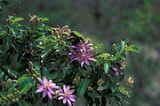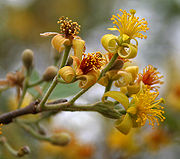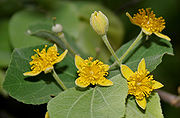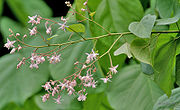
Grewia
Encyclopedia

-_khatkhati_in_hyderabad,_ap_w_img_9130.jpg)

Flowering plant
The flowering plants , also known as Angiospermae or Magnoliophyta, are the most diverse group of land plants. Angiosperms are seed-producing plants like the gymnosperms and can be distinguished from the gymnosperms by a series of synapomorphies...
genus
Genus
In biology, a genus is a low-level taxonomic rank used in the biological classification of living and fossil organisms, which is an example of definition by genus and differentia...
Grewia is today placed by most authors in the mallow family
Family (biology)
In biological classification, family is* a taxonomic rank. Other well-known ranks are life, domain, kingdom, phylum, class, order, genus, and species, with family fitting between order and genus. As for the other well-known ranks, there is the option of an immediately lower rank, indicated by the...
Malvaceae
Malvaceae
Malvaceae, or the mallow family, is a family of flowering plants containing over 200 genera with close to 2,300 species. Judd & al. Well known members of this family include okra, jute and cacao...
, in the expanded sense as proposed by in the APG
Angiosperm Phylogeny Group
The Angiosperm Phylogeny Group, or APG, refers to an informal international group of systematic botanists who came together to try to establish a consensus on the taxonomy of flowering plants that would reflect new knowledge about plant relationships discovered through phylogenetic studies., three...
. Formerly, it was placed in either the linden family (Tiliaceae
Tiliaceae
Tiliaceae is a botanical name for a family of flowering plants. Such a family is not part of APG II, but it is found all through the botanical literature and remains prominently listed by nomenclatural databases such as IPNI....
) or the Sparrmanniaceae
Sparrmanniaceae
Sparrmanniaceae is a segregate plant family, containing plants which have more commonly been classified in Malvaceae or Tiliaceae. In the most recent proposed circumscription, that of Cheek ex Heywood et al. , it corresponds to subfamily Grewioideae of the APG family Malvaceae ....
. However, these were both not monophyletic with respect to other Malvales
Malvales
Malvales are an order of flowering plants. As circumscribed by APG II-system, it includes about 6000 species within nine families. The order is placed in the eurosids II, which are part of the eudicots....
- as already indicated by the uncertainties surrounding placement of Grewia and similar genera - and have thus been merged into the Malvaceae
Malvaceae
Malvaceae, or the mallow family, is a family of flowering plants containing over 200 genera with close to 2,300 species. Judd & al. Well known members of this family include okra, jute and cacao...
. Together with the bulk of the former Sparrmanniaceae
Sparrmanniaceae
Sparrmanniaceae is a segregate plant family, containing plants which have more commonly been classified in Malvaceae or Tiliaceae. In the most recent proposed circumscription, that of Cheek ex Heywood et al. , it corresponds to subfamily Grewioideae of the APG family Malvaceae ....
, Grewia is in the subfamily Grewioideae
Grewioideae
Grewioideae is a subfamily of the Malvaceae family.The group is named after its type genus, Grewia, which is named for the English scientist Nehemiah Grew .-External links:*http://species.wikimedia.org/wiki/Grewioideae...
and therein the tribe
Tribe (biology)
In biology, a tribe is a taxonomic rank between family and genus. It is sometimes subdivided into subtribes.Some examples include the tribes: Canini, Acalypheae, Hominini, Bombini, and Antidesmeae.-See also:* Biological classification* Rank...
Grewieae, of which it is the type genus
Type genus
In biological classification, a type genus is a representative genus, as with regard to a biological family. The term and concept is used much more often and much more formally in zoology than it is in botany, and the definition is dependent on the nomenclatural Code that applies:* In zoological...
.
The genus was named by Carolus Linnaeus
Carolus Linnaeus
Carl Linnaeus , also known after his ennoblement as , was a Swedish botanist, physician, and zoologist, who laid the foundations for the modern scheme of binomial nomenclature. He is known as the father of modern taxonomy, and is also considered one of the fathers of modern ecology...
, in honor of the botanist Nehemiah Grew
Nehemiah Grew
Nehemiah Grew was an English plant anatomist and physiologist, very famously known as the "Father of Plant Physiology"...
(1641-1712) from England
England
England is a country that is part of the United Kingdom. It shares land borders with Scotland to the north and Wales to the west; the Irish Sea is to the north west, the Celtic Sea to the south west, with the North Sea to the east and the English Channel to the south separating it from continental...
. Grew was one of the leading plant anatomists and microscope
Microscope
A microscope is an instrument used to see objects that are too small for the naked eye. The science of investigating small objects using such an instrument is called microscopy...
researchers of his time, and his study of pollen
Pollen
Pollen is a fine to coarse powder containing the microgametophytes of seed plants, which produce the male gametes . Pollen grains have a hard coat that protects the sperm cells during the process of their movement from the stamens to the pistil of flowering plants or from the male cone to the...
laid the groundwork for modern-day palynology
Palynology
Palynology is the science that studies contemporary and fossil palynomorphs, including pollen, spores, orbicules, dinoflagellate cysts, acritarchs, chitinozoans and scolecodonts, together with particulate organic matter and kerogen found in sedimentary rocks and sediments...
.
Ecology and uses
Several LepidopteraLepidoptera
Lepidoptera is a large order of insects that includes moths and butterflies . It is one of the most widespread and widely recognizable insect orders in the world, encompassing moths and the three superfamilies of butterflies, skipper butterflies, and moth-butterflies...
caterpillar
Caterpillar
Caterpillars are the larval form of members of the order Lepidoptera . They are mostly herbivorous in food habit, although some species are insectivorous. Caterpillars are voracious feeders and many of them are considered to be pests in agriculture...
s are found to feed on Grewia species. These include the Common Nawab (Polyura athamas) and the swift moth Endoclita malabaricus. The Bucculatricidae
Bucculatricidae
Bucculatricidae or is a family of moths. This small family has representatives in all parts of the world. Some authors place the group as a subfamily of the family Lyonetiidae....
leaf miner
Leaf miner
Leaf miner is a term used to describe the larvae of many different species of insect which live in and eat the leaf tissue of plants. The vast majority of leaf-mining insects are moths , sawflies and flies , though some beetles and wasps also exhibit this behavior.Like Woodboring beetles, leaf...
Bucculatrix epibathra is apparently only found on G. tiliaefolia.
The parasitic wasp
Parasitic wasp
The term parasitoid wasp refers to a large evolutionary grade of hymenopteran superfamilies, mainly in the Apocrita. They are primarily parasitoids of other animals, mostly other arthropods...
Aprostocetus psyllidis of the Eulophidae
Eulophidae
Eulophidae is a large family of hymenopteran insects, with over 4,300 described species in some 300 genera . The family as presently defined also includes the genus Elasmus, which was previously treated as a separate family, "Elasmidae", and is now treated as a subfamily of Eulophidae...
occurs on and around Phalsa (G. asiatica). Its larvae are parasitoid
Parasitoid
A parasitoid is an organism that spends a significant portion of its life history attached to or within a single host organism in a relationship that is in essence parasitic; unlike a true parasite, however, it ultimately sterilises or kills, and sometimes consumes, the host...
s of other insects - possibly pests of the plant, but this is not known for sure.
Several species, namely Phalsa, are known for their edible fruit, which are of local commercial importance. The astringent
Astringent
An astringent substance is a chemical compound that tends to shrink or constrict body tissues, usually locally after topical medicinal application. The word "astringent" derives from Latin adstringere, meaning "to bind fast"...
and refreshing Grewia drupe
Drupe
In botany, a drupe is a fruit in which an outer fleshy part surrounds a shell of hardened endocarp with a seed inside. These fruits develop from a single carpel, and mostly from flowers with superior ovaries...
s are particularly popular in summertime. Folk medicine
Folk medicine
-Description:Refers to healing practices and ideas of body physiology and health preservation known to a limited segment of the population in a culture, transmitted informally as general knowledge, and practiced or applied by anyone in the culture having prior experience.All cultures and societies...
makes use of some species, which are reputed to cure upset stomachs and some skin and intestinal infections, and seem to have mild antibiotic
Antibiotic
An antibacterial is a compound or substance that kills or slows down the growth of bacteria.The term is often used synonymously with the term antibiotic; today, however, with increased knowledge of the causative agents of various infectious diseases, antibiotic has come to denote a broader range of...
properties. G. mollis is reputed to contain β-carboline
Beta-carboline
β-Carboline is an organic amine that is the prototype of a class of compounds known as β-carbolines.-Pharmacology:...
alkaloid
Alkaloid
Alkaloids are a group of naturally occurring chemical compounds that contain mostly basic nitrogen atoms. This group also includes some related compounds with neutral and even weakly acidic properties. Also some synthetic compounds of similar structure are attributed to alkaloids...
s, though whether such compounds occur in other species too and whether they are produced in quantities to render the plants psychoactive has not been thoroughly studied.
Selected species
- Grewia abutifolia (= G. sclerophylla Roxb. ex G. Don, Sterculia tiliacea Leveille)
- Grewia aldabrensisGrewia aldabrensisGrewia aldabrensis is a species of flowering plant in the Malvaceae sensu lato or Tiliaceae or Sparrmanniaceae family.It is found only in Seychelles.It is threatened by habitat loss.-Source:...
- Grewia asiaticaGrewia asiaticaGrewia asiatica is a species of Grewia native to southern Asia from Pakistan east to Cambodia, and widely cultivated in other tropical countries. Grewia celtidifolia was initially considered a mere variety of Phalsa, but is now recognized as a distinct species.It is a shrub or small tree growing...
– Phalsa, Falsa - Grewia avellana Hiern. (= G. calycina N.E.Br., G. hydrophila K.Schum., G. perennans K.Schum.)
- Grewia bicolor Juss. (= G. disticha Dinter & Burret, G. grisea, G. kwebensis N.E.Br., G. miniata Mast. ex Hiern., G. mossambicensis)
- Grewia biloba G.Don – Bilobed Grewia (= G. biloba var. glabrescens (Benth.) Rehder, G. glabrescens Benth., G. parviflora var. glabrescens (Benth.) Rehder & E.H.Wilson)
- Grewia biloba var. microphylla (Maxim) Hand.-Mazz. (= G. parviflora var. microphylla Maxim.)
- Grewia biloba var. parviflora (Bunge) Hand.-Mazz. (= G. chanetii H.Lév., G. parviflora Bunge, G. parviflora var. velutina Pampanini)
- Grewia bilocularisGrewia bilocularisGrewia bilocularis is a species of flowering plant in the Malvaceae sensu lato or Tiliaceae or Sparrmanniaceae family.It is found only in Yemen.-Source:* Miller, A. 2004. . Downloaded on 19 July 2007....
- Grewia caffra Meisn. (= G. fruticetorum J.R.Drummond ex Baker f.)
- Grewia calymmatosepala K.Schum.
- Grewia celtidifolia Juss. (= G. asiatica var. celtidifolia (Jussieu) L.F.Gagnepain, G. simaoensis Y.Y.Qian, G. yunnanensis H.T.Chang)
- Grewia ciclea – andilambarika (Malagasy)
- Grewia crenata (J.R.Forst.) Schinz & Guillaumin (= G. malococca, G. persicaefolia, G. prunifolia, Mallococca crenata) – au‘ere (Cook IslandsCook IslandsThe Cook Islands is a self-governing parliamentary democracy in the South Pacific Ocean in free association with New Zealand...
), fau ui (SamoaSamoaSamoa , officially the Independent State of Samoa, formerly known as Western Samoa is a country encompassing the western part of the Samoan Islands in the South Pacific Ocean. It became independent from New Zealand in 1962. The two main islands of Samoa are Upolu and one of the biggest islands in...
), fo ui (TongaTongaTonga, officially the Kingdom of Tonga , is a state and an archipelago in the South Pacific Ocean, comprising 176 islands scattered over of ocean in the South Pacific...
) - Grewia damine Gaertn. (= G. salviifolia B.Heyne ex Roth)
- Grewia eriocarpa Juss. (= G. boehmeriifolia Kanehira & Sasaki, G. elastica Royle, G. lantsangensis Hu)
- Grewia flava DC. (= G. cana Sond., G. hermannioides Harv.)
- Grewia flavescens Juss. (= G. flavescens var. longipedunculata Burret)
- Grewia glabra Blume – sometimes included in G. multiflora
- Grewia goetzeanaGrewia goetzeanaGrewia goetzeana is a species of flowering plant in the Malvaceae sensu lato or Tiliaceae or Sparrmanniaceae family.It is found only in Tanzania.-Source:* Lovett, J. & Clarke, G.P. 1998. . Downloaded on 19 July 2007....
- Grewia hexamita Burret (= G. messinica Burtt Davy & Greenway, G. schweickerdtii Burret)
- Grewia hirsuta Vahl.
- Grewia hornbyi Wild
- Grewia inaequilatera Garcke
- Grewia insularisGrewia insularisGrewia insularis is a species of flowering plant in the Malvaceae, or mallow family, that is endemic to Christmas Island, an Australian territory in the north-eastern Indian Ocean. Its specific epithet is the Latin for insular, referring to its island location.-Description:Grewia insularis is a...
Ridl. (Christmas IslandChristmas IslandThe Territory of Christmas Island is a territory of Australia in the Indian Ocean. It is located northwest of the Western Australian city of Perth, south of the Indonesian capital, Jakarta, and ENE of the Cocos Islands....
) - Grewia lasiocarpa E.Mey. ex Harv.
- Grewia limaeGrewia limaeGrewia limae is a species of flowering plant in the Malvaceae sensu lato or Tiliaceae or Sparrmanniaceae family.It is found only in Mozambique.-Source:* Bandeira, S. 1998. . Downloaded on 19 July 2007....
- Grewia microthyrsa K.Schum. ex Burret
- Grewia milleriGrewia milleriGrewia milleri is a species of flowering plant in the Malvaceae sensu lato or Tiliaceae or Sparrmanniaceae family.It is found only in Yemen.Its natural habitat is rocky areas.-Source:* Miller, A. 2004. . Downloaded on 19 July 2007....
- Grewia mollis Juss.
- Grewia monticola Sond. (= G. cordata N.E.Br., G. discolor, N.E.Br.)
- Grewia multiflora Juss. (= G. didyma Roxb. ex G.Don, G. disperma Rottler, G. guazumifolia Juss., G. jinghongensis Y.Y.Qian, G. oblongifolia Blume, G. serrulata DC.)
- Grewia occidentalisGrewia occidentalisGrewia occidentalis is a small, hardy, attractive tree indigenous to Southern Africa.A small, scrambling, deciduous tree reaching a height of about 3m, its purple, star-shaped flowers appear in summer, followed by distinctive four-lobed berries...
L. – Crossberry - Grewia olukondae Schinz. (= G. flavescens var. olukondae (Schinz) Wild)
- Grewia optiva J.R.Drumm. ex Burret (= G. oppositifolia Buch.-Ham. ex D.Don)
- Grewia oxyphylla Burret (= G. orientalis L.)
- Grewia pachycalyx K.Schum.
- Grewia retinervis Burret (= G. deserticola Ulbr.)
- Grewia retusifoliaGrewia retusifoliaGrewia retusifolia is a shrub species in the family Malvaceae. Common names include Dysentery Bush, Emu-berry, Dog's Balls, Turkey Bush and Diddle Diddle. It produces small, sweet, edible fruit. Indigenous Australians use the bark and leaves in medications....
Kurz - Grewia robusta
- Grewia salicifoliaGrewia salicifoliaGrewia salicifolia is a species of flowering plant in the Malvaceae sensu lato or Tiliaceae or Sparrmanniaceae family.It is found only in Seychelles.It is threatened by habitat loss.-Source:...
- Grewia schinzii K.Schum. (= G. velutinissima Dunkley)
- Grewia similis K.Schum.
- Grewia stolzii Ulbr.
- Grewia sulcata Mast.
- Grewis tembensis
- Grewia tenax (Forssk.) (= Chadara tenax Forssk., G. populifolia Vahl)
- Grewia tiliifolia Vahl (= G. rotunda C.Y.Wu, G. tiliaefolia (lapsusLapsusA lapsus is an involuntary mistake made while writing or speaking. According to Freud's early psychoanalytic theory, a lapsus represents a missed deed that hides an unconscious desire....
), Tilia rotunda C.Y.Wu & H.T.Chang) - Grewia transzambesicaGrewia transzambesicaGrewia transzambesica is a species of flowering plant in the Malvaceae sensu lato or Tiliaceae or Sparrmanniaceae family.It is found only in Mozambique.-Source:* Bandeira, S. 1998. . Downloaded on 19 July 2007....
- Grewia turbinataGrewia turbinataGrewia turbinata is a species of flowering plant in the Malvaceae sensu lato or Tiliaceae or Sparrmanniaceae family.It is found only in Yemen.Its natural habitat is subtropical or tropical dry forests.-Source:...
- Grewia villosaGrewia villosaGrewia villosa is locally endangered in some parts of its distribution.Grows only in natural habitats in rock crevices.Last seen in Shimba Hills in Kenya and in Ein Gedi oasis in Israel, common in South Africa.-External links:* *...
Formerly placed here
Some species once placed in Grewia (or genera synonymous with it) have since been moved elsewhere, particularly to MicrocosMicrocos
Microcos is a genus of flowering plant in the Malvaceae sensu lato or Tiliaceae or Sparrmanniaceae family.Species include:* Microcos erythrocarpa* Microcos globulifera* Microcos laurifolia...
:

- Alangium salviifolium (as G. salviifolia L.f.)
- Dombeya boehmiana (as Vincentia boehmiana (F.Hoffm.) Burret)
- Kleinhovia hospitaKleinhovia hospitaKleinhovia hospita is an evergreen, tropical tree native to Indonesia, Malaysia and other parts of tropical Asia. It is monotypic, being the only species in its genus.- Description :...
(as G. meyeniana) - Microcos chungii (as G. chungii Merr.
- Microcos nervosa – possibly belongs in M. paniculata (as G. nervosa (Lour.) Panigrahi)
- Microcos paniculataMicrocos paniculataMicrocos paniculata It is a plant that looks like a Shrub or small tree that is added in Chinese herbal tea. It is claimed to have medicinal value but this is unproven. The taste of this is Mildly sour...
(as G. microcos L. and possibly G. nervosa (Lour.) Panigrahi) - Microcos triflora (as G. stylocarpa Warb. and G. stylocarpa var. longipetiolata Merr.)
- Trichospermum mexicanum (as G. mexicana DC.)

